 |
||
|
||
| ||
We have already reviewed ASUSTeK mainboards of the CUSL2 series - CUSL2, CUSL2-C, CUSL2-BP. They are based on the Intel i815 chipset and its modifications, the descendant of the Intel 440BX. Today we will examine a new board of this series - the CUSL2-LS. The "LS" means, as usual, a network card and a SCSI controller onboard. But in case of the CUSL2-LS, the network and the SCSI controllers are implemented on a daughter card: 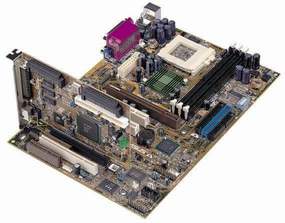 The company plans to sell the board both in a complete set (approximately $300), and separately - $160 for the board and $140 for a combined LAN/SCSI controller. The same approach will be used for CUV4X and CUV266 boards. Such technology has some advantages: boards don't need redesigning and cost relatively low. The disadvantages are also clear: the number of PCI slots decreases, extension cards can be used only on ASUS mainboards with a special slot. According to the manufacturer, they are not planning to produce extension cards other than LAN/SCSI. Besides, it is more beneficial to use the CUSL2-LS board than a CUSL2-C + Adaptec 39160 OEM + 3Com 905 set - $320 against $360. Besides, boards from other companies with similar functions are also more expensive, for example, the SuperMicro 370SSR costs around $450. The technical characteristics of the board do not differ much from those of the CUSL2: Specification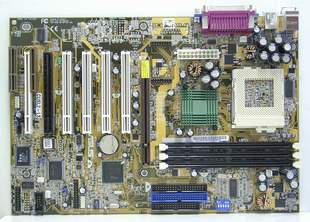
Specification of the LAN/SCSI card:
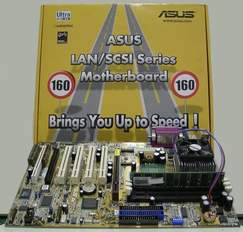 The board ships in quite a large box of a standard design, which includes:
The Manual for the LAN/SCSI card is highly detailed;
it includes a description of the controller installation, settings
for the mainboard, hard discs, installation of SCSI drivers and
a mini (4 pages) glossary for the terms used in this manual.  The only difference in the design from the CUSL2
is usage of a special "ASUS proprietary SCSI/LAN Slot" instead of
the fifth PCI slot. It looks like a usual PCI, only of another design
:). 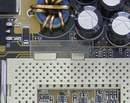 Another slight element of the design is usage of
small stickers made of transparent plastic located near the connectors
for mounting of a fan on a socket. It must protect the mainboard
when installing or demounting a cooling device of the processor.
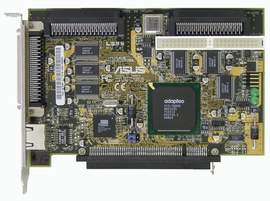 Now let's examine properly the most interesting part of the board - the LAN/SCSI controller. The 10/100BaseTX network controller based on the 3Com 3C920 chip is located on a small card (it is compatible in drivers with the popular 3Com 905 series). On the RJ45 connector for a network cable there are two LEDs - link/act and 10/100. The RPL/PXE BIOS in integrated in the Mainboard BIOS; it allows for booting a PC via a LAN from a server. But the WOL (wake-on-LAN) technology doesn't work with the LAN/SCSI card, that is why this feature requires another network card. The installed SCSI chip Adaptec 7899 makes possible to use two Ultra 160 SCSI channels. One channel has an internal and external 68-pin LVD connector, and the second features two internal ones - 68-pins and 50-pins. But since a special buffer chip is not used, then when not a LVD device (i.e. not the Ultra2 or Ultra 160) is used on any connector, including a 50-pin one, the whole channel works in the SE mode with the maximum speed equal to 40 MBytes/sec. On the right edge of the card one can find two LEDs that show the status of the first and the second channels of the SCSI controller and a standard connector for an external status indicator (common for both channels). The card has also a couple of jumpers for disabling a LAN or a SCSI controller. As for peculiarities, there is only one - a clamp on a special slot for a more reliable mounting of the LAN/SCSI card. Unfortunately, it requires special tools to open. OSs that support ACPI have no problems with adjustment of interrupt lines (we have checked it with the Windows 2000 and Windows 98SE). But without ACPI possibilities the situation might have been much worse - the devices on the card in a usual configuration take a large number of interrupts - 2 for SCSI, 2 for USB, 1 for LAN and 1 for SMBus. The CD supplied together with the board is just the same as for the CUSL2 board. The manufacturer included here drivers for the network card and the SCSI adapter in advance in order not to work out a new disc. Test resultsThe efficiency test results are very similar to those of the CUSL2, CUSL2-C boards, that is why we will omit them. But since the article without tests and illustrations is of little interest, we will try to compare the system operation with IDE and SCSI discs and correlate it with the price for the system. PC configuration:
The Intel Inf Update 2.90, Intel ATA 6.10, NVidia Detonator 12.40 drivers were installed. These discs have been chosen since their major parameters - a record density and an average access time - are very similar. The IDE disc was installed into the second channel of the integrated ATA100 controller, and the SCSI one was connected to its own controller. For the ZDLabs tests the discs had only NTFS partition, and for the IOMeter the MBR was completely deleted since the IOMeter preferred to work with a disc on a physical level. In this case (when only one disc is used) we do not compare SCSI and IDE technologies, but just try to ascertain in what applications these configurations differ. Our set of tests operates with quite weak interactive applications, while the vast majority of cases for SCSI usage is servers of files and applications intended for the simultaneous work with dozens of users. The first series of tests is ZDLabs Winbench 99
1.2, tests of the discs in different applications:
 That was expected, SCSI discs perform better at higher load, and IDE ones - at low load. But the 13.6% gap seems to be unjustified for a large price difference. But if you need exactly the high speed, then you must pay for it. Now let's study these results from another standpoint:
Here we can see that ratios of the CPU utilization to the speed coinside for the both discs. It means that such possibilities of SCSI as simultaneous processing of several requests doesn't matter for the applications of the ZDLabs Winbench 99 test, and operation of the IDE discs in UDMA modes also loads the processor not too much. So, for the most of users it is more beneficial to use the IDE in case of operation with only one disc. Now let's turn to the ZDLabs Business Winstone 2001 and Content Creation Winstone 2001 tests, which differ from the Winbench 99 in a set of applications used:  Again the SCSI wins by a little margin only in professional applications which are operating intensively with large volumes of data. As you might remember the Business Winstone 2001 is Microsoft Office 2000, Microsoft Project 98, Lotus Notes R5, NicoMak WinZip 7.0, Norton AntiVirus 98 and Netscape Communicator 4.73, and the Content Creation Winstone 2001 is Adobe Photoshop 5.5, Adobe Premiere 5.1, Macromedia Director 8.0, Macromedia Dreamweaver 3.0, Netscape Navigator 4.73 and Sonic Foundry Sound Forge 4.5. And now I will give you the results of the most powerful test of a disc subsystem - Intel IOmeter. Here are the parameters of the patterns:
One more parameter is the Queue Depth, for which we set the following values: 1, 32, 64, 128, 256. The time for each pattern was set to be 20 minutes, i.e. each disc was tested during more than 11 hours. This figure was taken with some reserve since the minimal data read/recorded during one test exceeded the disc size 10 times. As the tests show, the speed of operation in the Data Streaming Read/Write patterns doesn't depend on the Queue Depth parameter. And this is easy to explain - forming of a queue is not a random process, all requests go successively. That is why we will give averaged results for all Queue Depths for these tests separately: 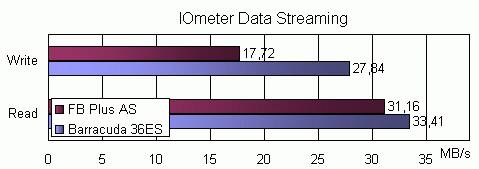 On the one hand, the advantage of the SCSI is well noticeable (especially when recording), but just look at the average of the CPU Effectiveness parameter which is a ratio of the number of I/O operations per unit of CPU utilization...  We make sure once more that there are fields where utilization of the SCSI may not give the desired facilitation for the processor. And usage of modern IDE discs in digital video recorders doesn't seem to be a bad idea. Now let's look at the remained patterns: 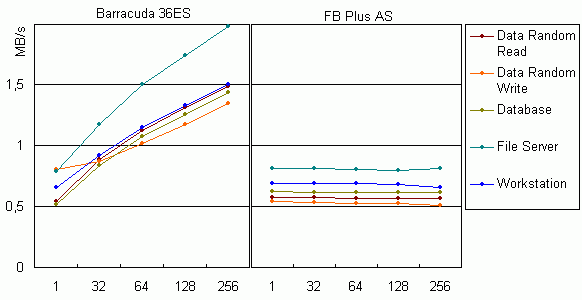 When data are required from different areas of a disc, and a queue depth of requests is growing, the SCSI starts revealing its might, while the IDE implements requests successively, and its behavior doesn't differ from one pattern to another. So, the tests show that a choice of an interface for a hard disc for usual application is standard - it is IDE. But if you need a high speed or good efficiency in a multitask system, then the SCSI excels here. We have compared the discs with the same rotation speed and the similar access time, record density and size. But among the SCSI discs there is a Cheetah X15 with 15,000 rpm and a Barracuda 180 with a gigantic size of 180 GBytes, that is why you can easily choose an appropriate disc for each task, but the wide possibilities of the SCSI cost not too little. The CUSL2-LS motherboard is an effective solution as far as power of the PC disc subsystem is concerned - in addition to two ATA100 channels it allows connecting 30 SCSI discs for two Ultra160 SCSI channels. But here the 133 MBytes/s PCI bus becomes a bottleneck. The board proved to be quite reliable since it stood the ZDLabs Winbench/Winstone and Intel IOmeter tests flawlessly during more than 30 hours. ConclusionThe new CUSL2-LS motherboard will undoubtedly take the appropriate place among powerful workstations and entry-level servers. It is the first time when a solution with a dual-channel Ultra160 SCSI controller costs so low - its price is lower than a retail package of a similar controller from Adaptec. And presence of an integrated video adapter will make possible to reduce the final cost of the CULS2-LS based server even more. Highs:
Lows:
Write a comment below. No registration needed!
|
Platform · Video · Multimedia · Mobile · Other || About us & Privacy policy · Twitter · Facebook Copyright © Byrds Research & Publishing, Ltd., 1997–2011. All rights reserved. | ||||||||||||||||||||||||||||||||||||||||||||||||||||||||||||||||||||||||||||||||||||||||||||||||||||||||||||||||||||||||||||||||||||||||||||||||||||||||||||||||||||||||||||||||||||